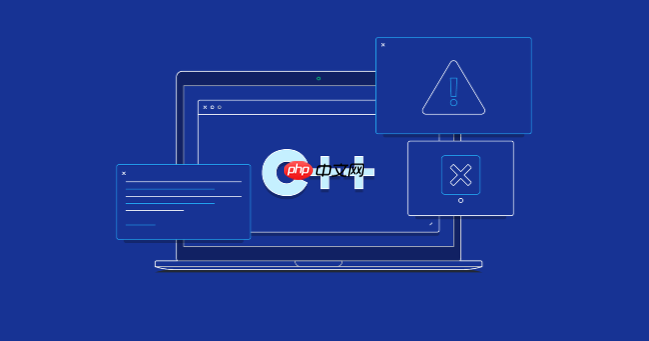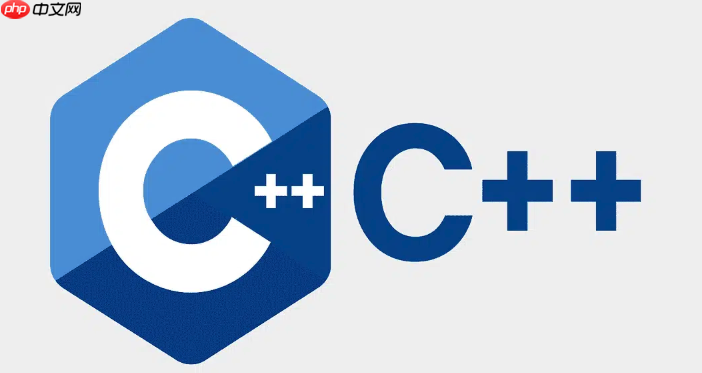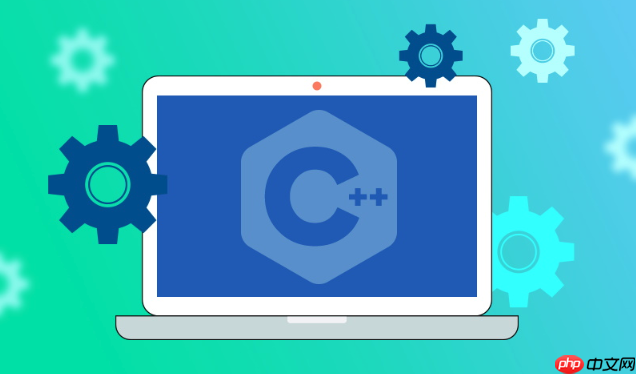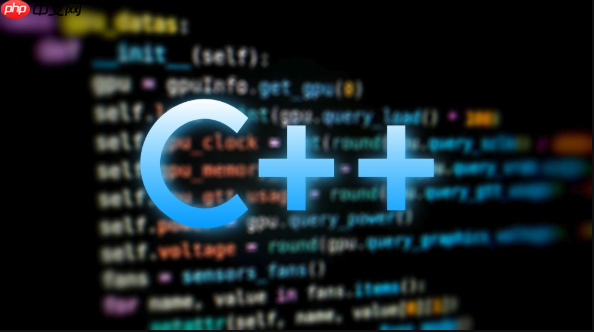工厂模式应优先返回智能指针以提升内存安全性、异常安全性及简化客户端资源管理。2. 使用std::unique_ptr或std::shared_ptr明确对象所有权,避免裸指针带来的内存泄漏和重复释放问题。3. std::unique_ptr适用于独占所有权场景,轻量高效且可转换为std::shared_ptr。4. std::shared_ptr用于共享所有权,需注意循环引用和性能开销。5. 智能指针结合raii原则确保资源在对象销毁时自动释放,增强代码健壮性。6. 客户端无需手动释放资源,提升代码简洁性和可维护性。

将智能指针融入工厂模式,特别是让工厂函数直接返回智能指针,是现代C++中一种非常推荐的做法。它解决了传统工厂模式中返回裸指针所带来的内存管理难题,极大地提升了代码的安全性、健壮性,并简化了客户端代码的资源管理负担。这不仅仅是语法上的一个变化,更是一种设计哲学上的进步,将RAII(资源获取即初始化)原则深入到对象创建的源头。

传统的工厂模式,其核心在于将对象的创建逻辑封装起来,根据传入的参数返回一个基类指针,指向实际创建的派生类对象。然而,当工厂函数返回
T*
delete

解决方案的核心是让工厂函数返回
std::unique_ptr<BaseProduct>
std::shared_ptr<BaseProduct>
考虑一个简单的产品体系:

#include <iostream>
#include <memory>
#include <string>
#include <map>
#include <functional>
// 抽象基类
class Product {
public:
virtual void use() const = 0;
virtual ~Product() = default;
};
// 具体产品A
class ConcreteProductA : public Product {
public:
void use() const override {
std::cout << "Using ConcreteProductA." << std::endl;
}
};
// 具体产品B
class ConcreteProductB : public Product {
public:
void use() const override {
std::cout << "Using ConcreteProductB." << std::endl;
}
};
// 工厂类(或者可以是一个独立的函数)
class ProductFactory {
public:
// 返回 unique_ptr 的工厂函数
static std::unique_ptr<Product> createProduct(const std::string& type) {
if (type == "A") {
// 使用 std::make_unique 更安全,避免裸 new
return std::make_unique<ConcreteProductA>();
} else if (type == "B") {
return std::make_unique<ConcreteProductB>();
} else {
// 抛出异常或返回 nullptr,具体取决于错误处理策略
std::cerr << "Unknown product type: " << type << std::endl;
return nullptr;
}
}
// 示例:使用函数映射的更灵活工厂
using ProductCreator = std::function<std::unique_ptr<Product>()>;
static std::map<std::string, ProductCreator> s_creators;
static void registerProduct(const std::string& type, ProductCreator creator) {
s_creators[type] = std::move(creator);
}
static std::unique_ptr<Product> createProductDynamic(const std::string& type) {
auto it = s_creators.find(type);
if (it != s_creators.end()) {
return it->second();
}
std::cerr << "Unknown product type (dynamic): " << type << std::endl;
return nullptr;
}
};
// 初始化静态成员(在实际应用中,这通常放在 .cpp 文件中)
std::map<std::string, ProductFactory::ProductCreator> ProductFactory::s_creators;
// 客户端代码示例
int main() {
// 注册产品,通常在程序启动时完成
ProductFactory::registerProduct("A", []{ return std::make_unique<ConcreteProductA>(); });
ProductFactory::registerProduct("B", []{ return std::make_unique<ConcreteProductB>(); });
// 使用工厂创建对象
auto product1 = ProductFactory::createProduct("A");
if (product1) {
product1->use();
}
auto product2 = ProductFactory::createProductDynamic("B");
if (product2) {
product2->use();
}
auto product3 = ProductFactory::createProduct("C"); // 尝试创建未知类型
if (!product3) {
std::cout << "Product C creation failed as expected." << std::endl;
}
// product1 和 product2 在 main 函数结束时自动销毁,无需手动 delete
return 0;
}这段代码展示了如何利用
std::unique_ptr
createProduct
unique_ptr
delete
unique_ptr
这其实是一个关于责任分离和资源管理哲学的问题。当你让工厂返回一个裸指针时,你实际上是将内存管理这件“脏活累活”甩给了调用方。调用方必须记住在何时何地对这个指针调用
delete
delete
delete
智能指针,尤其是
std::unique_ptr
std::shared_ptr
具体来说,优先考虑返回智能指针有以下几个关键原因:
delete
std::unique_ptr
unique_ptr
std::shared_ptr
try-catch-finally
delete
当然,这并不是说裸指针就一无是处了。在某些底层、高性能或者与C API交互的场景下,裸指针可能仍然有其用武之地。但在大多数业务逻辑和应用层面的对象创建中,智能指针无疑是更优、更安全的默认选择。
在决定工厂函数返回
std::unique_ptr
std::shared_ptr
优先选择 std::unique_ptr
std::unique_ptr
unique_ptr
unique_ptr
unique_ptr
unique_ptr
unique_ptr
shared_ptr
unique_ptr
shared_ptr
std::shared_ptr<Product> shared_prod = std::move(unique_prod);
何时考虑 std::shared_ptr
std::shared_ptr
shared_ptr
shared_ptr
std::shared_ptr
shared_ptr
shared_ptr
std::weak_ptr
shared_ptr
unique_ptr
shared_ptr
总结选择策略:
std::unique_ptr
std::shared_ptr
通过这种方式,工厂模式不仅能够封装对象的创建细节,还能通过智能指针清晰地表达和管理对象的生命周期,让整个系统更加健壮和易于维护。
智能指针在工厂模式中的应用,最核心的优势之一就是其对异常安全性的强大支持以及自动化的资源管理。这解决了传统裸指针工厂函数中一个非常头疼的问题:当对象创建过程中或创建后发生异常时,如何确保已分配的资源不被泄漏。
RAII 的核心作用: RAII(Resource Acquisition Is Initialization)原则是C++中管理资源的关键。它要求资源在对象构造时即被获取,并在对象析构时自动释放。智能指针正是RAII的完美体现。当工厂函数返回
std::unique_ptr
std::shared_ptr
std::make_unique
std::make_shared
new
new
对比裸指针的风险: 设想一个返回裸指针的工厂函数:
Product* createProductBad(const std::string& type) {
Product* p = nullptr;
if (type == "A") {
p = new ConcreteProductA();
} else if (type == "B") {
p = new ConcreteProductB();
}
// 假设这里有一些复杂的初始化逻辑,可能会抛出异常
// p->initialize(); // 如果 initialize() 抛出异常,p 就会泄漏!
return p;
}在这个例子中,如果
new ConcreteProductA()
p->initialize()
p
delete
智能指针的解决方案: 有了智能指针,同样的情况就变得异常安全:
std::unique_ptr<Product> createProductSafe(const std::string& type) {
std::unique_ptr<Product> p;
if (type == "A") {
p = std::make_unique<ConcreteProductA>();
} else if (type == "B") {
p = std::make_unique<ConcreteProductB>();
}
// 即使 p->initialize() 抛出异常,p 也会在栈展开时自动释放其管理的内存
// if (p) {
// p->initialize(); // 假设 initialize() 可能会抛出异常
// }
return p;
}在这里,无论
p->initialize()
p
unique_ptr
createProductSafe
delete
资源管理的简化: 除了异常安全性,智能指针还极大地简化了客户端的资源管理。客户端接收到智能指针后,无需关心何时何地调用
delete
在设计工厂模式时,拥抱智能指针不仅是技术上的升级,更是一种对代码质量和系统健壮性的承诺。它将内存管理的复杂性从业务逻辑中剥离,让开发者能够更专注于核心功能的实现,而不是被底层的资源生命周期问题所困扰。
以上就是智能指针在工厂模式中的应用 返回智能指针的工厂函数实现的详细内容,更多请关注php中文网其它相关文章!

每个人都需要一台速度更快、更稳定的 PC。随着时间的推移,垃圾文件、旧注册表数据和不必要的后台进程会占用资源并降低性能。幸运的是,许多工具可以让 Windows 保持平稳运行。

Copyright 2014-2025 https://www.php.cn/ All Rights Reserved | php.cn | 湘ICP备2023035733号